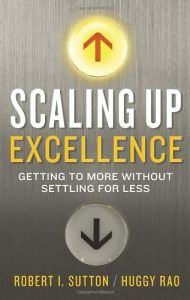Join getAbstract to access the summary!

Join getAbstract to access the summary!
Robert I. Sutton and Huggy Rao
Scaling Up Excellence
Getting to More Without Settling for Less
Crown, 2014
What's inside?
You can “scale up” the best ideas and behaviors across your company and its culture.
Recommendation
Stanford professors Robert I. Sutton and Huggy Rao team up to address and help solve the difficulties of scaling up. Almost every business has departments or even random pockets of employees who excel. Problems arise when leaders try to spread that excellence to scale throughout a company or in an expansion. Most organizations – regardless of size or specialization – face similar difficulties in spreading best practices or scaling excellence as they grow. The authors use numerous engaging case studies, cite myriad academic papers and offer anecdotal evidence to codify five rules of effective scaling. Surprisingly, given the clean, concise structure of Sutton’s best-selling The No Asshole Rule, here he and Rao don’t always distinguish their revelatory ideas from commonplace notions, and they repeat several points. Even so, this is an accessible, valuable work. getAbstract recommends their perceptive, practical guide to leaders coping with the challenges of scaling.
Summary
About the Authors
Professor Robert I. Sutton teaches management science and engineering at Stanford University, where professor Huggy Rao teaches organizational behavior in the Graduate School of Business.




















Comment on this summary